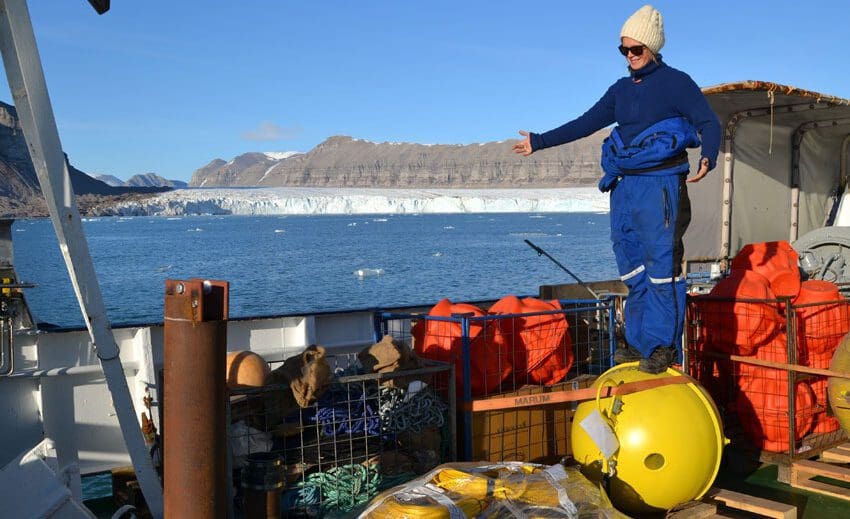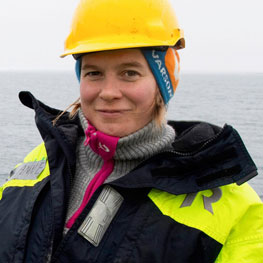Tides and weather affect transport of warm water to the Arctic

Eli Anne Ersdal on a scientific cruise northwest of Svalbard in August 2014. Photo: Ragnheid Skogseth/UNIS.
Top image: Eli Anne Ersdal ready for sampling off the northwest coast of Svalbard. Photo: Ragnheid Skogseth/UNIS.
Eli Anne Ersdal has studied how tides and weather affect how much energy is transported into the Arctic Ocean with the northernmost branch of the Gulf Stream. Ersdal will defend her PhD thesis on 2 November 2020.
28 October 2020
Press release from the University Centre in Svalbard (UNIS) and the University of Bergen
This study shows that both tides and weather north of Svalbard affect how much energy is transported into the Arctic Ocean with the northernmost branch of the Gulf Stream. Northwest of Svalbard, the warm Atlantic waters meet the underwater mountain Yermak Plateau. This relatively shallow area can be seen as a speed bump that the Atlantic water must either flow over or around in order to continue towards the Arctic Ocean. The main finding of the study is that the current route over the plateau is affected by both tides and weather.
The tide that dominates most sea areas on earth has a period of around 12.4 hours. In addition to this, there are several hundred weaker tidal periods that also contribute and overall, they can be seen as an interplay orchestra. It is already known that the steep slopes around the Yermak Plateau amplify the tide by a period of about one day.
This study shows that reinforcement is most effective when the current along the plateau is strong, which is the case in winter. This finding is based on model runs combined with measurements of current along the plateau. Measurements of current on the plateau show that longer tidal periods with a duration of around 14 and 28 days are also intensified in winter. Ersdal and colleagues therefore suggest that the intensified tide with a period of about one day, transfers some of the energy to the long tide periods. In practice, the warm Atlantic water will flow towards the Arctic Ocean and the sea ice for one to two weeks before it turns and brings colder water back.
The weather also has a great influence on the intensity of the current and which route it takes over the plateau. Southerly winds blowing along the coast accelerate both the current west of Svalbard and the innermost and shortest route across the plateau. When the wind blows from the north, these weaken and now the Atlantic water takes instead a longer and more northern route over the plateau.
Disputation
Eli Anne Ersdal will defend her PhD thesis entitled “Ocean motion in the Yermak Plateau – tidal and air-ocean interactions” on 2 November 2020 at 09:00.
Details on the disputation event
The committee consists of:
Opponent: Angelika Renner, Institute of Marine Research
Opponent: Leon Chafik, Stockholm University
Committee leader: Lars Henrik Smedsrud, University of Bergen and UNIS
Disputation leader: Noel Keenlyside, University of Bergen
Ersdal has been supervised by Frank Nilsen, UNIS and University of Bergen; Johnny A. Johannessen, University of Bergen, Jan Even Øie Nilsen, Institute of Marine Research and Knut Barthel, University of Bergen.
Ersdal completed a trial lecture entitled “The importance of the Bering Strait inflow for the Arctic Ocean” on 26 October 2020.

About the candidate
Eli Anne Ersdal was born in Tromsø in 1982. In 2009 she completed her master’s degree in geophysics with a specialization in physical oceanography at the Department of Geophysics at University of Bergen and the University Centre in Svalbard (UNIS).
She worked as a state meteorologist at the Meteorological Institute in Tromsø from 2010, before returning to UNIS in the autumn of 2013 where she started her doctorate. Now she works for Wyssen Avalanche Control.